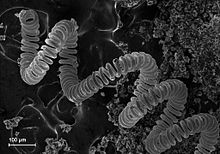
Back Gloeilamp Afrikaans Bombeta AN مصباح متوهج Arabic বিজুলী বাতি Assamese Llámpara incandescente AST Opokotcan ATJ Elektrik lampası Azerbaijani Alektrėnė lėmpele BAT-SMG Bumbilya BCL Лямпа напальвання Byelorussian
This article has an unclear citation style. The reason given is: there are a few "author-date" style citations contrary to predominant citation style, that ALSO directly hyperlink the page number to Google. (November 2024) |



An incandescent light bulb, incandescent lamp or incandescent light globe is an electric light with a filament that is heated until it glows. The filament is enclosed in a glass bulb that is either evacuated or filled with inert gas to protect the filament from oxidation. Electric current is supplied to the filament by terminals or wires embedded in the glass. A bulb socket provides mechanical support and electrical connections.
Incandescent bulbs are manufactured in a wide range of sizes, light output, and voltage ratings, from 1.5 volts to about 300 volts. They require no external regulating equipment, have low manufacturing costs, and work equally well on either alternating current or direct current. As a result, the incandescent bulb became widely used in household and commercial lighting, for portable lighting such as table lamps, car headlamps, and flashlights, and for decorative and advertising lighting.
Incandescent bulbs are much less efficient than other types of electric lighting. Less than 5% of the energy they consume is converted into visible light; the rest is lost as heat.[1][2] The luminous efficacy of a typical incandescent bulb for 120 V operation is 16 lumens per watt (lm/W), compared with 60 lm/W for a compact fluorescent bulb or 100 lm/W for typical white LED lamps.[3]
The heat produced by filaments is used in some applications, such as heat lamps in incubators, lava lamps, Edison effect bulbs, and the Easy-Bake Oven toy. Quartz envelope halogen infrared heaters are used for industrial processes such as paint curing and space heating.
Incandescent bulbs typically have shorter lifetimes compared to other types of lighting; around 1,000 hours for home light bulbs versus typically 10,000 hours for compact fluorescents and 20,000–30,000 hours for lighting LEDs. Most incandescent bulbs can be replaced by fluorescent lamps, high-intensity discharge lamps, and light-emitting diode lamps (LED). Some governments have begun a phase-out of incandescent light bulbs to reduce energy consumption.
- ^ Keefe, T.J. (2007). "The Nature of Light". Archived from the original on 23 April 2012. Retrieved 5 November 2007.
- ^ "High Efficiency Incandescent Lighting | MIT Technology Licensing Office". tlo.mit.edu. Retrieved 19 August 2022.
- ^ Vincenzo Balzani, Giacomo Bergamini, Paola Ceroni, Light: A Very Peculiar Reactant and Product. In: Angewandte Chemie International Edition 54, Issue 39, (2015), 11320–11337, doi:10.1002/anie.201502325.